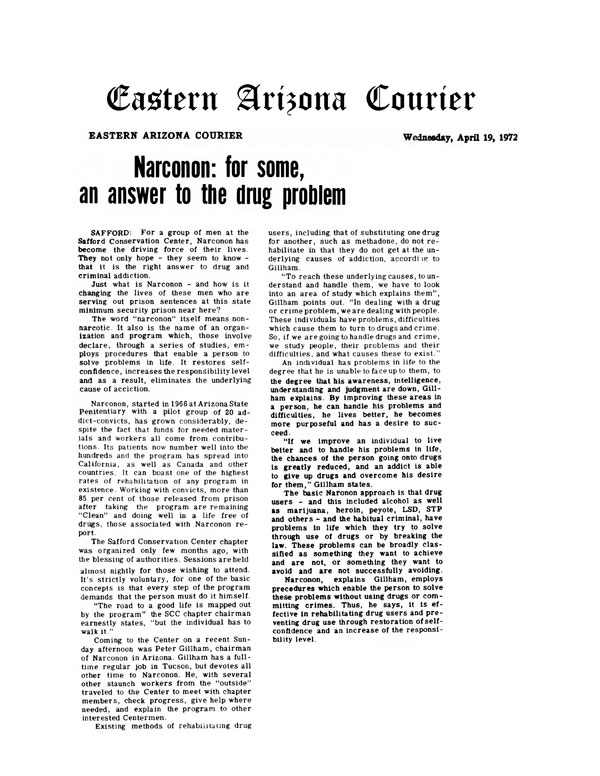Eastern Arizona Courier Narconon Newspaper Article

An Answer to the Drug Problem
Wednesday, April 19, 1972
Narconon: for some, an answer to the drug problem
SAFFORD: For a group of men at the Safford Conservation Center, Narconon has become the driving force of their lives. They not only hope - they seem to know - that it is the right answer to drug and criminal addiction.
Just what is Narconon - and how is it changing the lives of these men who are serving out prison sentences at this state minimum security prison near here?
The word “Narconon” itself means non-narcotic. It also is the name of an organization and program which, those involve declare, through a series of studies, employs procedures that enable a person to solve problems in life. It restores self confidence, increases the responsibility level and as a result, eliminates the underlying cause of addiction.
Narconon, started in 1966 at Arizona State Penitentiary with a pilot group of 20 addict-convicts, has grown considerably, despite the fact that funds for needed materials and workers all come from contributions. Its patients now number well into the hundreds and the program has spread into California, as well as Canada and other countries. It can boast one of the highest rates of rehabilitation of any program in existence. Working with convicts, more than 85 per cent of those released from prison after taking the program are remaining “Clean” and doing well in a life free of drugs, those associated with Narconon report.
The Safford Conservation Center chapter was organized only few months ago, with the blessing of authorities. Sessions are held almost nightly for those wishing to attend. It’s strictly voluntary, for one of the basic concepts is that every step of the program demands that the person must do it himself.
“The road to a good life is mapped out by the program” the SCC chapter chairman earnestly states, “but the individual has to walk it.”
Coming to the Center on a recent Sunday afternoon was Peter Gillham, chairman of Narconon in Arizona. Gillham has a fulltime regular job in Tucson, but devotes all other time to Narconon. He, with several other staunch workers from the “outside” traveled to the Center to meet with chapter members, check progress, give help where needed, and explain the program to other interested Centermen.
Existing methods of rehabilitating drug users, including that of substituting one drug for another, such as methadone, do not rehabilitate in that they do not get at the underlying causes of addiction, according to Gillham.
“To reach these underlying causes, to understand and handle them, we have to look into an area of study which explains them”, Gillham points out. “In dealing with a drug or crime problem, we are dealing with people. These individuals have problems, difficulties which cause them to turn to drugs and crime. So, if we are going to handle drugs and crime, we study people, their problems and their difficulties, and what causes these to exist.”
An individual has problems in life to the degree that he is unable to face up to them, to the degree that his awareness, Intelligence, understanding and judgment are down, Gillham explains. By Improving these areas in a person, he can handle his problems and difficulties, he lives better, he becomes more purposeful and has a desire to succeed.
“If we improve an individual to live better and to handle his problems in life, the chances of the person going onto drugs is greatly reduced, and an addict is able to give up drugs and overcome his desire for them,” Gillham states.
The basic Narconon approach is that drug users - and this included alcohol as well as marijuana, heroin, peyote, LSD, STP and others - and the habitual criminal, have problems in life which they try to solve through use of drugs or by breaking the law. These problems can be broadly classified as something they want to achieve and are not, or something they want to avoid and are net successfully avoiding.
Narconon, explains Gillham, employs procedures which enable the person to solve these problems without using drugs or committing crimes. Thus, he says, it is effective in rehab1litating drug users and preventing drug use through restoration of self-confidence and an increase of the responsibility level.